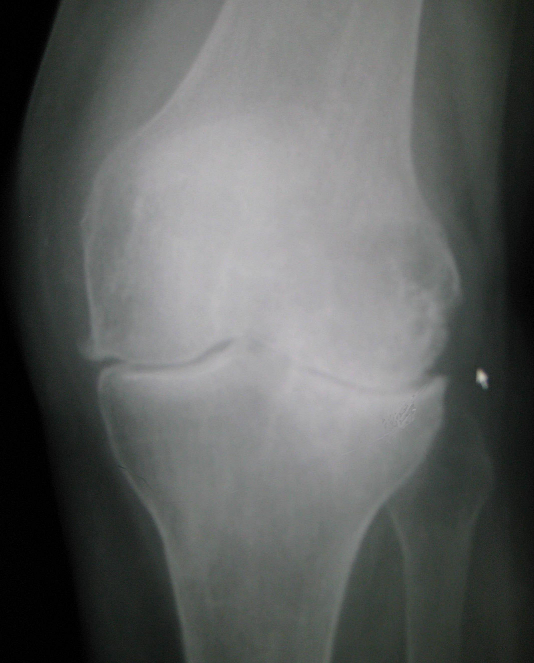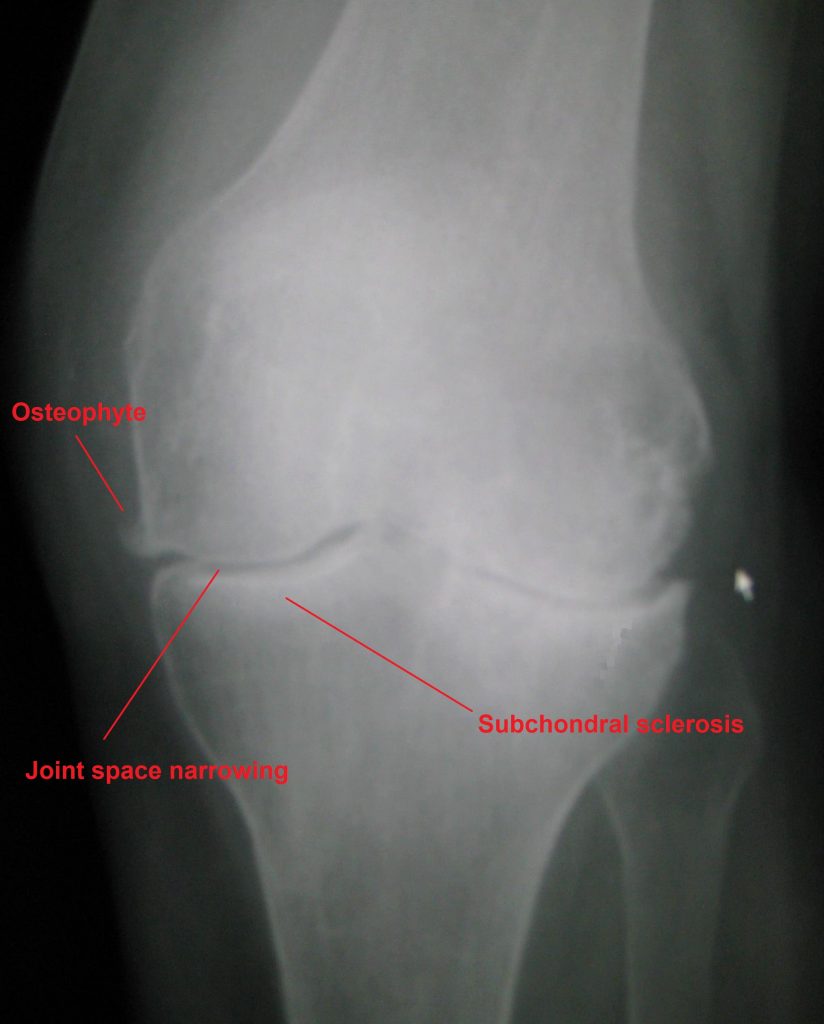
Musculoskeletal

A 60 year old man attends the Emergency Department with a painful left knee which has been increasing in severity over the past week. He tells you it is painful to walk on and becomes stiff after sitting for a period. An x-ray is performed at triage. What is the diagnosis?
Answer:
Typical radiological features of osteoarthritis include:- Subchondral bone thickening (sclerosis) and/or cysts
- Osteophyte formation (new bone formation at joint margins)
- Loss or narrowing of the joint space (provides an estimate of the severity of cartilage damage).
Osteoarthritis
Musculoskeletal
Last Updated: 14th December 2023
Osteoarthritis is defined as a disorder of synovial joints which occurs when damage triggers repair processes leading to structural changes within a joint.
These repair processes alter the structure of the joint over time, causing typical features of:
- Localised loss of cartilage.
- Remodelling of adjacent bone and the formation of osteophytes (new bone at joint margins).
- Mild synovitis (inflammation of the synovial membrane that lines the joint capsule).
In some people, these repair processes may alleviate symptoms, but in others they cannot fully compensate for the joint damage, and symptoms of pain and stiffness may occur.
Joint damage may occur through repeated excessive loading and stress of a joint over time, or by injury. Any synovial joint can be involved, and the most commonly affected peripheral joints are the knees, then the hips, and the small joints of the hand.
Risk factors
The exact causes of osteoarthritis are not fully known. It is a complex and multifactorial condition involving genetic, biological, and biomechanical components.
- Genetics
- Biological
- Increasing age
- Female sex
- Obesity
- High or low bone density
- Biomechanical
- Joint injury and damage
- Occupational and recreational stresses on joints
- Joint laxity and reduced muscle strength
- Joint malalignment
Clinical features
Suspect a diagnosis of osteoarthritis if alternative conditions have been excluded and a person is aged 45 years or more, with suggestive clinical features.
- Symptoms
- Activity-related joint pain — typically only one or a few joints are affected at any one time, and pain develops over months or years, and
- No morning joint-related stiffness, or morning stiffness lasting no longer than 30 minutes.
- Signs
- Bony swellings and joint deformities
- Bouchard’s nodes (bony nodules on proximal interphalangeal joints)
- Heberden’s nodes (bony nodules on distal interphalangeal joints)
- Joint effusions
- Joint warmth and/or tenderness
- Muscle wasting and weakness
- Restricted and painful range of joint movement
- Joint crepitus
- Joint instability
- Antalgic gait
- Bony swellings and joint deformities
X-ray
Routine X-ray of the affected joint(s) is not usually needed to confirm the diagnosis. Consider arranging an X-ray, depending on clinical judgement:
- If there is diagnostic uncertainty.
- To exclude alternative conditions.
- If there is a sudden clinical deterioration in symptoms
Typical radiological features of osteoarthritis include:
- Subchondral bone thickening (sclerosis) and/or cysts
- Osteophyte formation (new bone formation at joint margins)
- Loss or narrowing of the joint space (provides an estimate of the severity of cartilage damage).
Note: structural changes on X-ray may not correlate with reported symptoms and functional impairment.

Osteoarthritis. (Image by James Heilman, MD (Own work) [CC BY-SA 3.0 , via Wikimedia Commons)
Management
- Analgesia
- Paracetamol
- Topical NSAIDs
- Oral NSAIDs
- Opioids
- Topical capsaicin
- Intra-articular corticosteroids for moderate-to-severe joint pain
- Physical treatments
- Strengthening exercises
- Aerobic fitness training
- Physiotherapy
- Assisted devices for activities of daily living
- Local heat/cold packs
- Supports and braces for biomechanical joint pain/instability
- Appropriate footwear for lower limb arthritis
- Surgery
- Refer if the person has joint symptoms (pain, stiffness, and reduced function) that have a substantial impact on their quality of life and are refractory to non-surgical treatment.
- Surgical treatment usually involves joint replacement or fusion. Arthroscopic lavage and debridement may be considered for people with knee osteoarthritis with a clear history of mechanical locking. Hand involvement may be treated by excision of the trapezium or joint fusion.
- Complications of joint replacement may include aseptic loosening, pain, dislocation, infection, and fracture.
Complications
- Joint deformity
- Functional impairment and disability
- Psychosocial impact
- Occupational impact
- Falls
- Chronic pain syndrome
Report A Problem
Is there something wrong with this question? Let us know and we’ll fix it as soon as possible.
Loading Form...
- Biochemistry
- Blood Gases
- Haematology
| Biochemistry | Normal Value |
|---|---|
| Sodium | 135 – 145 mmol/l |
| Potassium | 3.0 – 4.5 mmol/l |
| Urea | 2.5 – 7.5 mmol/l |
| Glucose | 3.5 – 5.0 mmol/l |
| Creatinine | 35 – 135 μmol/l |
| Alanine Aminotransferase (ALT) | 5 – 35 U/l |
| Gamma-glutamyl Transferase (GGT) | < 65 U/l |
| Alkaline Phosphatase (ALP) | 30 – 135 U/l |
| Aspartate Aminotransferase (AST) | < 40 U/l |
| Total Protein | 60 – 80 g/l |
| Albumin | 35 – 50 g/l |
| Globulin | 2.4 – 3.5 g/dl |
| Amylase | < 70 U/l |
| Total Bilirubin | 3 – 17 μmol/l |
| Calcium | 2.1 – 2.5 mmol/l |
| Chloride | 95 – 105 mmol/l |
| Phosphate | 0.8 – 1.4 mmol/l |
| Haematology | Normal Value |
|---|---|
| Haemoglobin | 11.5 – 16.6 g/dl |
| White Blood Cells | 4.0 – 11.0 x 109/l |
| Platelets | 150 – 450 x 109/l |
| MCV | 80 – 96 fl |
| MCHC | 32 – 36 g/dl |
| Neutrophils | 2.0 – 7.5 x 109/l |
| Lymphocytes | 1.5 – 4.0 x 109/l |
| Monocytes | 0.3 – 1.0 x 109/l |
| Eosinophils | 0.1 – 0.5 x 109/l |
| Basophils | < 0.2 x 109/l |
| Reticulocytes | < 2% |
| Haematocrit | 0.35 – 0.49 |
| Red Cell Distribution Width | 11 – 15% |
| Blood Gases | Normal Value |
|---|---|
| pH | 7.35 – 7.45 |
| pO2 | 11 – 14 kPa |
| pCO2 | 4.5 – 6.0 kPa |
| Base Excess | -2 – +2 mmol/l |
| Bicarbonate | 24 – 30 mmol/l |
| Lactate | < 2 mmol/l |

